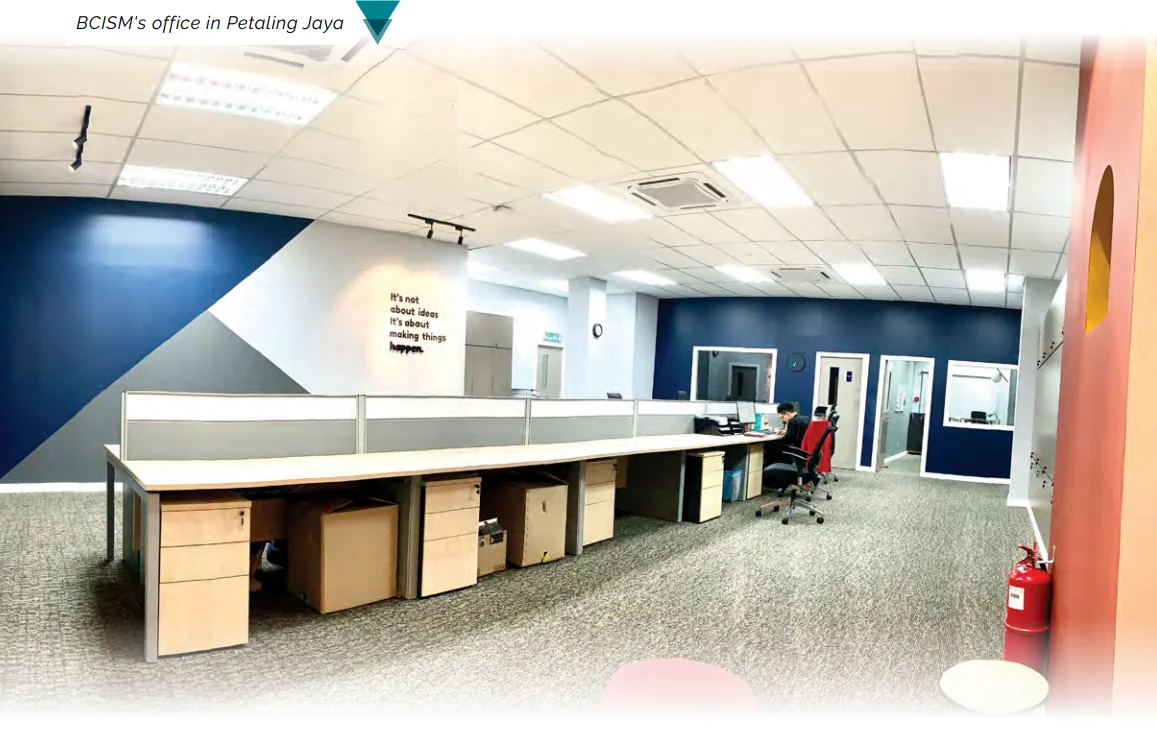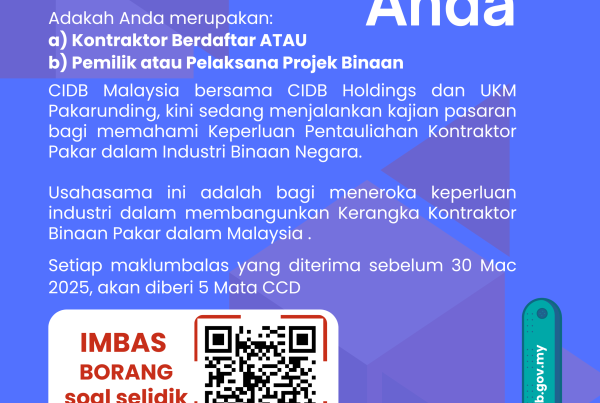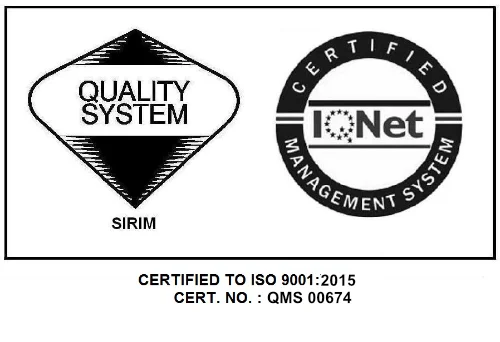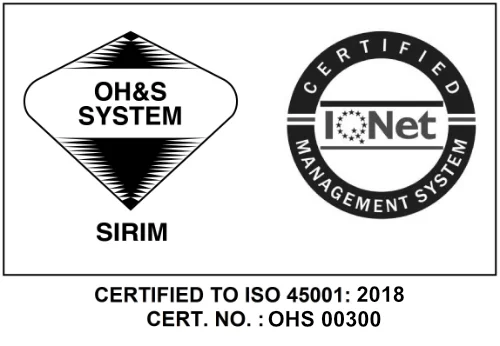The launch of BCISM Sdn Bhd in July 2019 heralds a new era of greater efficiency, productivity and transparency for the construction industry in Malaysia.
Building Cost Information Services Malaysia (BCISM) Sdn Bhd is a collaborative effort between the CIDB Malaysia and the Royal Institution of Surveyors Malaysia (RISM) to operate MyN3C portal, a centralised data bank for construction costs in Malaysia.
“The BCISM model is similar to BCIS UK, which has collected, analysed and interpreted cost information for the past 50 years. Today, BCIS UK makes this information easily accessible through online applications, data licensing and publications; and this is what BCISM aspires to do as well,” says Sr Nazir Muhamad Nor, General Manager of BCISM.
“It is a long time coming,” states Sr Kwan Hock Hai, Director of BCISM, divulging that the industry does not have anything similar to the annual Spon’s price books nor the UK’s BCIS subscription for pricing info. “Information is a vital element in making decisions. Thus, having timely and locally sourced costing data is a great boon to everyone related to the construction industry from contractors, consultants, quantity surveyors, suppliers, insurance and banks.”
Breaking The Culture Of Data Silos
Malaysia’s construction industry faces a lack of access, accuracy, breadth and depth of industry data; most of which are due to data silos and a reluctance by most parties to share information as they are viewed as trade secrets. “While cost information is available via various organisations in the Malaysian construction industry, most of it is only for the use of that particular organisation and is not easily accessible by third parties,” says Sr Wan Ainon Zuraiha Khalid, Chairperson of BCISM. “Small contractors with minimal costing data will greatly benefit from this extensive database.”
“The cost data in Malaysia is only made available within the consultant’s firms. They keep their own data for the internal use and for their own reference,” Nazir laments.
Those days will soon be in the past with the inception of BCISM. As the main service provider of centralised building cost information for the industry and its stakeholders, BCISM will provide cost information in a highly accessible online channel and thus assisting Malaysian construction industry players in the preparation of early cost estimates, cost planning, benchmarking, whole life costing, Building Information Modelling (BIM), Market Research, Economic Reports, Price Movement Assessments and cost forecasting.
Currently, all information within MyN3C (www.myn3c.cidb. gov.my) is available free of charge until May 2020 for the first 17,000 existing users. BCISM will introduce new subscription packages in the near future. “CIDB and BCISM are constantly innovating and exploring ways to improve our offerings and contributions to the industry. As such, we are in the process of introducing new features and upcoming developments to MyN3C for the benefit of our subscribers,” explains Nazir.
Upcoming features will include:
- a) Construction Cost Benchmark
- b) Tender Price Index
- c) Construction Cost Book
- d) Lifecycle Costing
- e) Online Promotional Platform
- f) Other services, such as bespoke training, cost consultation and Construction Economic Report
To date, the MyN3C Portal contains:
- a) Building Materials Prices
- b) Labour Wage Rates
- c) Machinery Hire Rates and Equipment Purchase Prices
- d) Materials Cost Index
- e) Labour Cost Index
- f) Machinery and Equipment Cost Index
- g) Building Cost Index
Source & Frequency of Updates
- a) Building Materials Prices: Monthly
- b) Labour Wage Rates: Half-yearly
- c) Machinery Hire Rates and Equipment Purchase Prices: Half-yearly
- d) Materials Cost Index: Monthly
- e) Labour Cost Index: Monthly
- f) Machinery and Equipment Cost Index: Monthly
- g) Building Cost Index: Monthly
The Importance Of Accurate Cost Data
“Imagine the Great Pyramid of Giza minus its top or our very own PETRONAS Twin Towers without the connecting bridge. That would be the unfortunate fate of most projects without access to accurate cost data,” says Nazir. “Simply put, accurate cost data allow us to avoid risks and pitfalls that are commonly attributed to unreliable, back-of-the envelope calculations and ballpark figures. Accurate projections enable us to plan budgets ahead of time, preventing any unwanted surprises such as running over the budget.”
In the construction world where Pareto’s Principle decrees that 20% of the design encompasses 80% of the cost, it makes a lot of sense to bank on BCISM’s data to expedite accurate cost planning, claims Kwan.
In a typical scenario of a simple project, the client will appoint a professional architect and engineer to come up with the project design. A professional quantity surveyor (QS) will then provide a Bill of Quantities (BOQ) detailing the work that needs to be done, e.g., building materials, wages and equipment. The work will then be priced. According to Nazir, building materials represent 65 per cent of the total cost of construction. “The information provided by BCISM on building materials prices, workers’ wages, machinery rent rates and equipment prices will serve as a guide in preparing estimates of construction project costs. Insurers will use the cost data to provide competitive quotations for the premiums and building insurance.”
RISM is grateful to CIDB for providing invaluable data in collaboration with the relevant associations and suppliers of materials. “Without CIDB’s initiative and involvement, we would never have reached this stage of information sharing that is so crucial to move the industry forward,” says Nazir.
Wan Ainon is optimistic that the advent of BCISM will enable the QS to accomplish more analytical work resulting in more precise costing. “Rather than view BCISM as a threat to the profession because it is shaving off a bulk of the price sourcing work of a QS, I view it as an advancement to the QS community. It will cut down the amount of time a QS has to spend on chasing after data, increasing their efficiency, and making better use of their talents for analytical thinking so that they can contribute invaluable insights to the project.”
Sr Loo Ming Chee, Director of BCISM quips that the data from BCISM is best treated as an indication of the overall cost as there will be a substantial builders discount based on the payment terms and relationship between the contractor and supplier. “One will be able to view the cost trends but not the absolute cost per se. The overall construction cost is accurate, but in terms of granular details, it would not be too precise as the sample sizes at the moment are not too large.” He added that the data is useful when looking at alternatives and making comparisons, such as light brick walls which are structurally lighter versus red brick walls.
Towards Better Resource Planning and Long-term Operational Sustainability
Currently, construction professionals in Malaysia are still practising the traditional way of preparing the cost estimates, which is by referring to similar past projects. This is all well and good when one is only focused on one or two clients. “But what happens when there is a need to diversify? One would have to scramble to get accurate information on these brand new sectors,” says Nazir. “To remain relevant and be able to adapt to the frequent changes in the market, we need a platform like BCISM,” says Nazir.
Dato’ Sr Sri Kandan, Director of BCISM, envisions BCISM to be further developed as the central source of a full spectrum of information including capital costing, whole life cycle costing, and maintenance costing. “We are moving towards that aim as we believe that projects should be ultimately designed to cost in order to achieve budget feasibility. Additionally, when purchasing a built asset, we must strive to achieve value for money. This means taking into consideration the whole life cycle cost of that project or life cycle costing, as some would call it. This would then achieve optimum balance in time, quality and cost.” He further states that it is common to have maintenance costs be four to five times more than the cost of capital over the course of 20 to 25 years. “So if your project cost is RM100mil, the maintenance cost could be around RM400 to 500mil. By knowing the maintenance costs earlier on, this will prevent situations where the repair costs are higher than anticipated, resulting in poorly-maintained buildings.”
“Data is undeniably the new oil in our industry. For timely, on-budget projects, pre-planning with accurate cost data is crucial to mitigate unwelcome surprises. Savvy project managers and industry players will do well to utilise BCISM’s services and be a part of the digital transformation trend overtaking the construction industry,” says Kwan.








